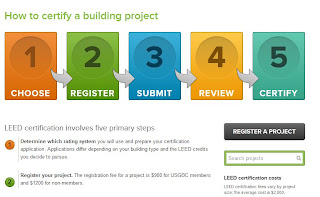A certification system that offers a stamp of approval on "green" building is getting streamlined and greener - at least that's what its backers hope. The LEED (Leadership in Energy and Environmental Design) certification system was launched by the U.S. Green Building Council (USGBC) in 1998 and has since gone international.
Clinching LEED certification, both for new and existing buildings, can mean higher status and lower operating costs for prospective tenants, which equates to higher rental dollars for landlords. Levels of certification - from basic to platinum - require builders to earn more "points" in efficiency, recycled or renewable building materials, and site impact. Critics of the certification system say the process is expensive and time consuming, something USGBC hopes to address, including revamping its web site and launching LEED-related mobile apps.
 |
| Graphic on applying for LEED. Image: USGBC web site |
The updated LEED certification process features a streamlined application, allocates 20 percent of all points to building energy efficiency, and adds a new "Location and Transportation category that rewards projects for utilizing existing development infrastructure, embracing the principles of walkability, connectivity, density and quality alternative transportation."
Municipalities can play a significant role in determining how "green" a building is - think Metro stops and bike share programs - and Arlington has been attentive to providing infrastructure to support higher LEED rankings. Mobility Lab, Arlington's transportation innovation arm, is a way of supporting "greener" transportation through such practices as limiting the demand for single occupancy vehicle commutes and offering information about alternative transportation options.
 |
| Founder's Square - proposed LEED. Image: Shooshan Companies |
Wendy Duren of Arlington Transportation Partners (ATP) said her organization has shepherded over 100 site plans through the LEED process. ATP, a complimentary service of Arlington County, offers services such as training for tenants on transportation options and customized transportation information.
"We are here to assist you [the developer] and make that [LEED] binder process a little less intimidating," Duren said.
Developer Kevin Shooshan, of The Shooshan Company, said Arlington County offered so many resources, it made sense to apply for LEED. "It's not logical right now to not develop to a LEED standard because of the bonuses Arlington County is offering," he said. His company's Founder's Square building is part of a LEED Neighborhood Development certification test phase.
He said transit-oriented development involved some forethought on the part of developers. "You have to give metro cards to new tenants, you have to put bike racks all over the place," Shooshan said. “As a developer it's another thing you have to do, but it's the right thing for the future.”
The USGBC has invited developers to participate in a beta test phase of LEED V4, what it says will be a streamlined application procedure. Testers will give feedback to help improve the process. The public comment period ends December 10th.
 RSS Feed
RSS Feed Twitter
Twitter 7:04 AM
7:04 AM
 Unknown
Unknown






0 comments:
Post a Comment